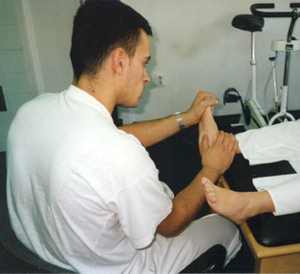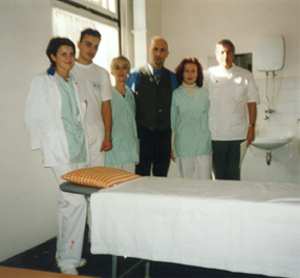Positive Health Online
Your Country

Reflexology reaches out to Bosnia
listed in reflexology, originally published in issue 41 - June 1999
My first glimpse of Bosnia, Sarajevo to be precise, was on a Sunday early in February 1998, as the aeroplane from Vienna was descending amongst the surrounding mountains.
It was natural curiosity to stare from the aircraft window to get a first glimpse of a war-torn countryside. Buildings with severely damaged roofs and many without roofs and others simply a heap of rubble were the collective scars of previous bitter conflict.
A snow covered Sarajevo airport greeted us with basic facilities and an outside temperature of –9°C as my colleague, Linda Rumbles and I checked through customs.
We were in Sarajevo as representatives of the International Institute of Reflexology (IIR). The purpose was to provide basic practitioner training, with qualification by the IIR standard examinations, to a team of physiotherapists – this would enable them to be self-sufficient in treating the widespread trauma cases caused during the Bosnian war years.
The war had ended in 1996 and the city was recovering itself with the aid of a number of European countries and of Japan which, linked to the European initiatives, supplied a fleet of modern buses. British efforts were visible in the continued restoration of mains supplies of gas and other essential services.
The trams and trolley busses were running again and were amazingly frequent. Ironically, this service would be the envy of many of Britain's cities. Maybe, some of our councils could learn a thing or two from Sarajevo's public transport system! The vehicles are fairly ancient and certainly basic – with non-upholstered metal seats – but they serve their public to its apparent satisfaction.
Regarding the training programme, all the hand-out material for the first two UK modules of training were translated into Bosnian prior to departure. We were indebted to Lada Copic for the invaluable help she gave us throughout.
The physiotherapists started work at 8.00am and their day finished at 3.00pm. After 30 minutes rest, their training in reflexology was undertaken on three consecutive evenings, finishing at between 6.30pm and 7.00pm, depending upon the degree of tiredness of the students.
Teaching, on the first trip, was done in the confined space of the old Medical Centre and, on the subsequent visits, it was conducted in the new Medical Centre which is situated about a half mile from the old one.
Lecture sessions were conducted via our on-site physiotherapist 'translator', Fikreta Lelovic. Again, grateful thanks are due to Fikreta without whose help the whole programme would not have been possible. Fikreta managed to combine her own learning with translating for her friends and colleagues.
We were surprised to find the relatively low level of understanding of anatomy and physiology – it had been assumed that we could summarise this aspect and so provide greater time to perfect the techniques of the Original Ingham Method®. It was not until the second visit that we learned that the war had interrupted their earlier studies and they were reluctant to admit what they did not know. So time was spent in helping them to overcome this deficit.

Avdovic Jasmin perfecting his technique & not forgetting to look at his 'patient'!

Dr Muptic (Director, Medical Centres) 3rd from right at presentation of certificates to some
of his physiotherapists (New Medical Centre, October '98)
The rewarding thing throughout was their enthusiasm and dedication. Between the first trip in February – when the temperature was –9°C and it snowed most days, and the second trip in June – when the temperature was 84°F+, with high humidity, the physiotherapists were too busy coping with public demand to have much chance of practising their reflexology techniques. But within a day of our returning in June and after only one 'refresher' evening, they were up to speed and coping well with Modules 3 and 4 and a subsequent verbal mock theory examination.
The third and final visit was in October when the weather was variable from mild to winter cold. The three weeks were spent summarising and refreshing the course to date and, as before, treating members of the public. The theory and practical/oral examinations were taken on the second Saturday and the results were made known on the following Friday. This allowed sufficient time to present the Diploma Certificates which had been especially produced in Bosnian.
The qualifying examinations were to the usual International Institute of Reflexology standard – requiring a minimum pass mark of 80% on the three-hour theory paper and an assessed similar standard in the practical/oral examination. The only difference was the theory paper was confined to the translated hand-outs (which were expanded and supplemented with photographs). This was because the recommended textbooks were not available in Bosnian! The English draft paper, with its marking schedule, was submitted to Head Office in the USA for approval and upon its return was sent to Lada Copic for translation into Bosnian, i.e. both the examination and its marking schedule were now in Bosnian.
Students were able to use their native language in the theory examination and the marking schedule was used to mark the papers by a medic appointed by the Director of the Medical Centres. This was a procedure agreed previously with the Director as the best way of removing any hint of favouritism, either by him or us; thus an impartial third person marked the papers against the marking schedule.
There was mutual relief and two-way gratitude that all the students were successful. The amount of work they put in between visits two and three had been quite phenomenal and we were very proud of each of them.
Throughout the three visits to Sarajevo, we worked alongside the physiotherapists in treating members of the public who receive treatment free at the point of delivery. During my last trip, I had a 'block' of 15 patients within 2 days and 30 to 40 treatments were given per week. Many of the patients were treated daily – for just 15/20 minutes at a time and after they had had their physiotherapy treatment.
There were some tragic cases – almost everyone has a tragic story to tell about the recent war years. But there were also some very humble experiences – of a lady whose shoulder pain was eased for the first time in over a year; the asthmatic man who spent the week-end after his first treatment, being sick and coughing up phlegm but who felt so much better by the Monday; a lady with arthritis who had less pain, more movement and warmth in her feet for the first time in 20 years! and there were many similar 'dramatic' improvements in increased mobility, decreased pain and boosted well-being.
It was indeed refreshing to work in an environment that was not preoccupied with the need for scientific evidence and research, where everyone was concerned only with being treated. To work in an atmosphere in which the public and the Doctors accept the improvement they can see with their own eyes, backed by what the patients tell them, was an additional bonus. In short, everyone was too busy getting on with the job – there was very little time to stand, stare or criticise.
Equally, the patients themselves could be embarrassingly grateful and would back this with unsolicited and quite unexpected gifts of gratitude. It is customary for the physiotherapists to get a regular supply of chocolates, fruit, breakfasts! or lunches! donated by grateful patients.
During the time of my visits to Sarajevo, from February to October 1998, the City and its suburbia has produced tangible signs of recovery. From the outset there were areas of great contrast. You could stand in a street and look at a devastated block of flats and yet turn to look at the opposite side of the street and see either an old building that was untouched or, in a few cases, a brand new building. Much of the old part of the City has remained intact, although all buildings that survived have the scars of bullet and shell damage: they are pock marked like chickenpox.
Peace exists officially and sustained largely by the visible presence of the UN troops. These were even more evident during the October trip when Kosova was unstable and Slobodan Milosevic was given an ultimatum. There was a strange feeling of extreme friendliness and undoubted welcome and yet, at the same time, an underlying tension which perhaps has its roots too deeply set in ethnic and religious differences to be otherwise.
Regarding the people, I consider myself very privileged to have been given the opportunity to work on and for people of such generous nature. Also, it makes you feel humble and makes you question some of the priorities we have: we expect a refrigerator in our kitchen – they are grateful for a kitchen. We have become so spoiled with material comforts of all kinds that the idle time this has produced too often is used to criticise unfairly and to argue over minutiae; or to destroy aspects of our life that have stood the test of time and are valued by others outside the UK.
To the friends in Sarajevo, thank you for putting some aspects of life and its true value into perspective and for the experiences shared. May you enjoy better health and be allowed to live in peace which is threatened when the UN dithers whilst killing continues in Kosova – will we never learn?
Comments:
-
No Article Comments available